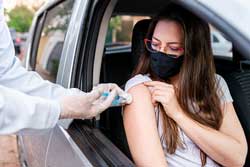NEW YORK—Early risers Friday morning were greeted with the encouraging news from Johnson & Johnson that its COVID-19 vaccine candidate showed overall positive results in a Phase 3 clinical trial. If approved, the J&J vaccine would be the third vaccine available in the U.S. for offsetting the coronavirus’ spread. The real upside to the J&J vaccine, though, is that it’s a single-dose regimen and doesn’t have the storage challenges associated with the Pfizer/BioNTech vaccine, the first vaccine to receive FDA approval.
J&J said it planned to apply for FDA emergency use authorization as soon as next week, which would put it on track to receive clearance later in February. The J&J vaccine was 72 percent effective in the U.S. and 66 percent effective overall at preventing moderate to severe COVID-19 in the period 28 days after vaccination, according to the company’s announcement. In the J&J trial, a 44,000-participant study was conducted in the U.S., South America and South Africa.
 |
While the efficacy results are lower than the 94 percent to 95 percent effectiveness of the Moderna (the second vaccine to be approved in the U.S.) and Pfizer vaccines, the J&J results are reasons for optimism, according to the National Institutes of Health, as reported by WebMD.
Specifically, the fact that the clinical trials showed the Johnson & Johnson vaccine was 85 percent effective in preventing severe cases of COVID was very important, WebMD reported Friday.
Separately, a Bank of America securities analyst said in a note that the overall positive aspect of the J&J data indicates “the vaccine will likely become a contributor to achieving herd immunity and getting back to normal.”
The J&J news comes amid a swirl of conflicting news about COVID-19, including a push by the Biden administration to speed up the immunization process for Americans and the passing of the one-year mark since the first case was diagnosed in the U.S. on Jan. 21, 2020, in the state of Washington. At the same time, there are reports that the vaccine supply has been tightening and the number of COVID-19 cases globally surpassed 100 million (or 1.3 percent of the world’s population) in mid-week, according to Reuters.
 |
In addition, Novavax reported Thursday that its COVID-19 vaccine achieved 89.3 percent efficacy in a Phase 3 clinical trial that enrolled subjects exposed to the B.1.1.7 variant found in the U.K. But the Novavax vaccine performed worse in a smaller phase 2b trial that matched it against another variant first identified in South Africa. As a result, some observers expressed concern that there will be a need to have updated prophylactics to protect against the evolving virus.
Some other key developments in the COVID-19 from the past week:
• Pfizer and BioNTech reported Wednesday that their vaccine neutralized SARS-CoV-2 key mutations present in the U.K. and South Africa variant of the virus. The South Africa variant is reported to be more virulent and may have a higher death rate.
• The European Union on Friday announced plans to effectively halt any attempt by AstraZeneca to move vaccine doses manufactured in the bloc to other countries unless it first meets its supply obligations to the bloc’s 27 member states. The EU move came shortly after the AstraZeneca vaccine was recommended for conditional marketing authorization in the European Union. (The AstraZeneca vaccine has not been approved in the U.S.)
• A Women In Optometry poll found that 88 percent of respondents had received at least one of the two injections of the COVID-19 vaccine. More than 600 people participated in the poll. Sixty percent of the respondents had received one dose of the Moderna vaccine, and 21 percent one dose of the Pfizer vaccine.
• WebMD also reported Friday that the first confirmed cases of the South African coronavirus variant in the U.S. have been detected in South Carolina, according to the state’s Department of Health and Environmental Control said. One case was found in the northeast section of the state, and the other in the Lowcountry along the coast. The two adults have no travel history and have no known connection, according to the WebMD report.
On a more positive note, the number of new COVID-19 cases in the U.S. have fallen 34 percent during the past 2 weeks, according to data compiled by The New York Times. The U.S. reported more than 155,000 new cases Wednesday. At the peak three weeks ago, more than 300,000 new cases were reported each day. Cases continue to decline in 45 states, the newspaper reported. California is reporting about 25,000 new cases per day, which is down from the peak of 44,000.
Editor’s Note: Don’t miss the January/February issue of Vision Monday where we will list our top news stories of the year as well as our most popular features from VMAIL Weekend. Look for the Digital Edition coming your way on Feb. 8 via VisionMonday.com.
|